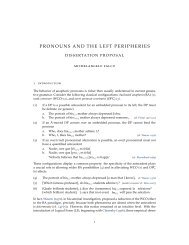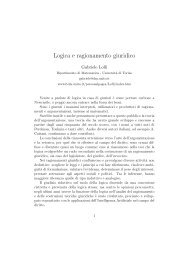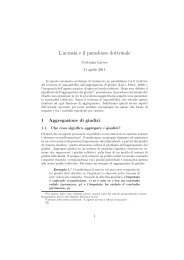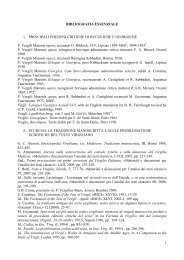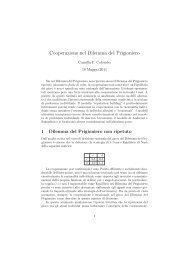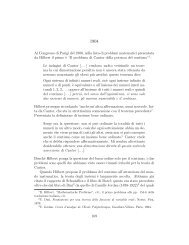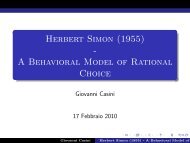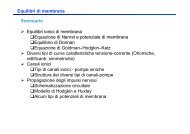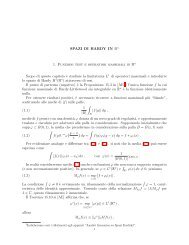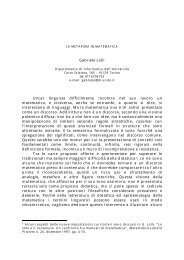Scavalcamento Debole e Catene in Forma Logica - Pagine ...
Scavalcamento Debole e Catene in Forma Logica - Pagine ...
Scavalcamento Debole e Catene in Forma Logica - Pagine ...
You also want an ePaper? Increase the reach of your titles
YUMPU automatically turns print PDFs into web optimized ePapers that Google loves.
2.3 – Tests di Specificità<br />
b. The very few books that/∅ there were on his shelves were all mysteries<br />
LF: the very few books Op.Rel. that/∅ there were xfewbooks on his<br />
shelves were all mysteries<br />
(Heim (1987, es. 33-30), esempi e giudizi ripresi da Safir (1982))<br />
La relativa <strong>in</strong> (39b) è un esempio di relativa “amount” nei term<strong>in</strong>i di Carlson<br />
(1977), cioè una relativa che co<strong>in</strong>volge quantità o descrizioni di gradi. Questa <strong>in</strong>terpretazione<br />
può essere colta <strong>in</strong> term<strong>in</strong>i semantici solo se a LF la frase contiene un’occorrenza<br />
di x-many Ns <strong>in</strong> posizione di traccia, <strong>in</strong>vece di una variabile <strong>in</strong>dividuale<br />
come accade <strong>in</strong> (39a).<br />
Dunque le <strong>in</strong>terrogative con how many e le relative amount con there costituiscono<br />
dei test di non–specificità. Cioè quando la traccia di un elemento può occorrere<br />
nelle frasi con there esistenziale, siamo di fronte ad un elemento non specifico e ci<br />
aspettiamo che <strong>in</strong>sorgano effetti di WCO. Gli esempi come al solito sono modificati<br />
rispetto agli orig<strong>in</strong>ali al f<strong>in</strong>e di <strong>in</strong>serire la complicazione del WCO <strong>in</strong> maniera pragmaticamente<br />
plausibile. I diacritici di grammaticalità sulle <strong>in</strong>terrogative <strong>in</strong> (40b) e<br />
le relative <strong>in</strong> (40b) <strong>in</strong>dicano che le predizioni si realizzano: 19<br />
(40) a. How many soldiers does the commander th<strong>in</strong>k there are <strong>in</strong> the <strong>in</strong>firmary?<br />
b. ?* [How many soldiers]i does theiri commander th<strong>in</strong>k there are <strong>in</strong> the<br />
<strong>in</strong>firmary?<br />
(41) a. These supplies should be enough for the very few soldiers that the<br />
commander th<strong>in</strong>ks there are <strong>in</strong> the trenches at this po<strong>in</strong>t.<br />
b. ?* These supplies should be enough for [the very few soldiers]i that theiri<br />
commander th<strong>in</strong>ks there are <strong>in</strong> the trenches at this po<strong>in</strong>t.<br />
Se il test di base da un risultato agrammaticale, il s<strong>in</strong>tagma estratto è specifico<br />
(42a). In questo caso è necessario usare un esempio dist<strong>in</strong>to per testare la configurazione<br />
di WCO aff<strong>in</strong>chè si manifesti una sospensione dell’effetto. La predizione<br />
che l’effetto non emerge perchè il s<strong>in</strong>tagma è specifico è confermata dai giudizi di<br />
grammaticalità forniti dai miei <strong>in</strong>formatori:<br />
(42) a. ?? Which students does the professor th<strong>in</strong>k there are <strong>in</strong> the great-hall?<br />
b. [Which students]i does theiri professor th<strong>in</strong>k are <strong>in</strong> the great-hall?<br />
19 I diacritici riportati nel testo costituiscono una tendenza nei giudizi forniti dagli <strong>in</strong>formatori:<br />
non tutti i parlanti hanno espresso giudizi uniformi e concordanti su tutte le costruzioni.<br />
53



